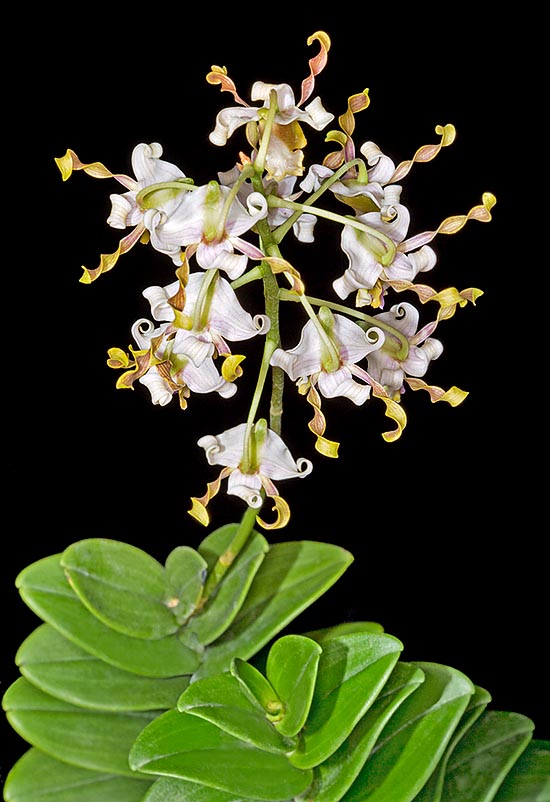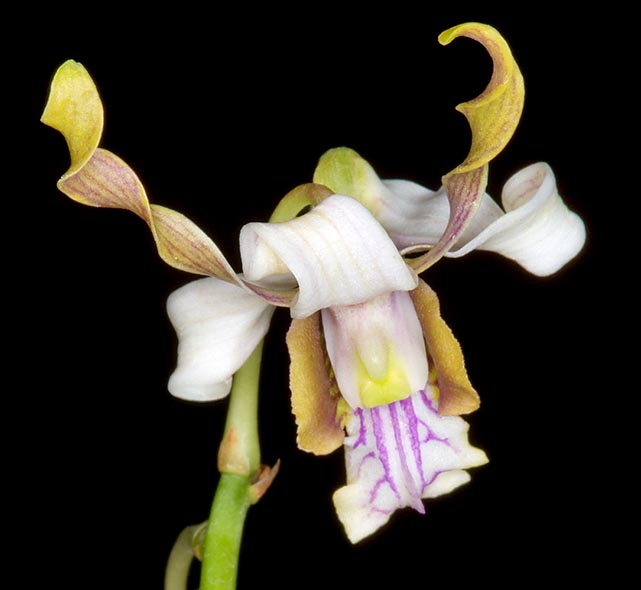Family : Orchidaceae

Text © Pietro Puccio

English translation by Mario Beltramini

Dendrobium pseudoconanthum grows as epiphyte, at low altitude, in Sulawesi Island © G. Mazza
The name of the genus is the combination of the Greek substantives “δένδρον” (dendron) = tree and “βίος” (bios) = life, with reference to the numerous species of the genus living on the trees.
The name of the species is formed by the Greek prefix “ψευδής” (pseudés) = false and by the name of the species of the Dendrobium conanthum Schltr. (1912).
The Dendrobium pseudoconanthum J.J.Sm. (1926) is an epiphytic species with long up to 2 m fusiform pseudobulbs provided of alternate, distichous, coriaceous, thick about 10 cm and glossy intense green leaves.
Inflorescences from the upper nodes, horizontal or semi-erect, 20-30 cm long, carrying numerous flowers of 2,5-3,5 cm of diameter.
Linear sepals with greenish white pointed apex, undulated and bent backwards; the lateral sepals, merged at the base of the column, form a sort of a spur (mentum).
Spatulate petals, almost erect, twisted, greenish with purple violet venations, trilobed greenish white labellum run by violaceous venations with erect lateral lobes and curved median lobe.
It reproduces by seed, in vitro, and division, to be done by the vegetative restart, with each section provided of at least 3-4 pseudobulbs.
Rare species in cultivation, requires high luminosity, also some hours of direct sun, medium-high temperatures, 22-32 °C, during the vegetative period, high humidity, 60-80%, and constant ventilation; averagely cooler temperatures during the vegetative stasis, with minimum ones not less than 15 °C.
The waterings must be regular and abundant during the growth of the pseudobulbs, to be done in the morning in way to allow the roots to quickly dry up before the evening, being particularly sensitive to the rottenness, reduced during the vegetative stasis.

Rare in cultivation, has 20-30 cm inflorescences with 2,5-3,5 cm flowers © Giuseppe Mazza
The fertilizations, duly distributed in way to avoid salts accumulation at the roots, are to be done during the vegetative period preferably with hydrosoluble balanced products, with microelements, at ¼ of the dosage suggested on the package.
Preferably, it is cultivated in pots or in baskets, seen the dimensions the pseudobulbs may reach, with particularly draining and aerated compost that can be formed by medium sliced bark and charcoal fragments, with possible addition of inerts for improving the drainage.
Transplants and repottings are to be done when strictly necessary by the vegetative restart, signalled by the appearance of the new roots.
The species is reported in the appendix II of the CITES (species whose trade is internationally ruled).
Synonyms:
Durabaculum pseudoconanthum (J.J.Sm.) M.A.Clem. & D.L.Jones (2002).
→ For general notions about ORCHIDACEAE please click here.
